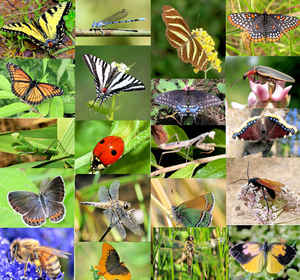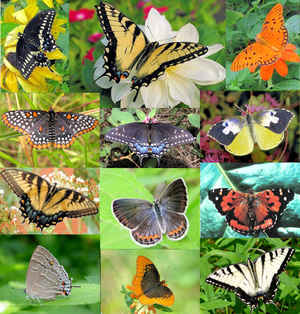Alabama Symbols
Alabama State Mascot and Butterfly
Eastern Tiger Swallowtail

(Papilio glaucus)
Adopted on May 2, 1989
On May 2, 1989 the Eastern Tiger Swallowtail, (Papilio glaucus,) was designated as Alabama official state mascot and butterfly. In addition to the appointment of the state butterfly, Selma has been appointed the Butterfly Capitol of Alabama.
The swallowtail bill was requested by the City Council
of Selma, Alabama. The tiger swallowtail had earlier become the mascot of Selma, the "Butterfly Capital of Alabama." Also, the Alabama Garden Clubs
had helped set aside April 16 as Alabama's official "Save the Butterfly Day." Finally, the butterfly resolution noted that official butterflies had
already been adopted by California, Georgia, Illinois,
Maryland, and Oregon.
Residents of Selma first adopted the eastern tiger swallowtail because it is native, highly visible, and beautiful. They wanted to draw attention to
the plight of butterflies. Several species had been placed on the endangered species list because of pesticides.
But Selma is a butterfly paradise. Residents cultivated plants that provide food to butterfly larvae and nectar for the adults. They designed a flag
depicting a butterfly. Teachers taught about butterflies in local schools. Selma School District's paper was called the Butterfly Times.
Alabama State Mascot & Butterfly
Eastern Tiger Swallowtail

The Eastern Tiger Swallowtail (Papilio glaucus) is a species of swallowtail butterfly native to North America. It is one of the most familiar butterflies in the eastern United States, where it is common in many different habitats. It flies from spring to fall, during which it produces two to three broods. Adults feed on the nectar of many species of flowers, mostly from those of the Apocynaceae, Asteraceae, and Fabaceae families. P. glaucus has a wingspan measuring 7.9 to 14 cm (3.1 to 5.5 in). The male is yellow with four black "tiger stripes" on each fore wing. Females may be either yellow or black, making them dimorphic. The yellow morph is similar to the male, but with a conspicuous band of blue spots along the hindwind, while the dark morph is almost completely black.
The green eggs are laid singly on plants of the Magnoliaceae and Rosaceae families. Young caterpillars are brown and white; older ones are green with two black, yellow, and blue eyespots on the thorax. The caterpillar will turn brown prior to pupating. It will reach a length of 5.5 centimetres (2.2 in). The chrysalis varies from a whitish color to dark brown. Hibernation occurs in this stage in locations with cold winter months.
The first rendering of this species was of an adult male, drawn in 1587 by John White, commander of Sir Walter Raleigh's third expedition to North America. Some females, particularly those in the North, are black, with some blue interlaced with black bands on the hind wings. These females superficially resemble the poisonous blue pipevine swallowtail, Battus philenor.
Characteristics of the Eastern Tiger Swallowtail
Life Cycle
- Two flights generally occur in the north, and three or four flights take place as far south as Florida.
- Male swallowtails fly at treetop level and descend to mate with lower-flying females.
- Females lay single, globular greenish-yellow eggs on the surface of leaves, and the young larvae that result are dark and resemble bird droppings.
- The two-inch-long mature larva or caterpillar is bright green and swollen in front, with false black and orange eyespots. These larvae spin a silk "mat" on the leaf, which curls the edges of the leaf somewhat.
- Larvae feed until they are full-grown, then develop into a dark brown or greenish brown caterpillar and descend the trunk of the tree and pupate on the ground, creating a dark stick-like chrysalis in which they overwinter.
- The pupa is light brown with a dark brown or black lateral stripe and dark brown dorsal band.
Habitat
The tiger swallowtail is widely distributed from New England west through the southern Great Lakes area (along Merriam's "transition life zone") through most of the Great Plains states and south to Texas and Florida. In the transition zone, the eastern tiger swallowtail is sympatric with the closely related Canadian tiger swallowtail, Papilio canadensis (until recently, considered a subspecies of P. glaucus).
Alabama Law
The law designating the Eastern Tiger Swallowtail as the official Alabama state ibutterfly is found in the Unannotated Code of Alabama 1975, Title 1, Chapter 2, Section 1-2-23
TITLE 1.
Chapter 2 STATE SYMBOLS AND HONORS.
Section 1-2-23
State butterfly.
The Eastern Tiger Swallowtail is hereby designated as the official mascot and butterfly of the State of Alabama.
(Acts 1989, No. 89-676, p. 1341.)
Taxonomic Hierarchy: Eastern Tiger Swallowtail
Kingdom: Animalia (Animals)
Phylum: Arthropoda (Arthropods)
Subphylum: Hexapoda (Hexapods)
Class: Insecta (Insects)
Order: Lepidoptera (Butterflies and Moths)
Superfamily: Papilionoidea (Butterflies and Skippers)
Family: Papilionidae (Swallowtails, Parnassians)
Subfamily: Papilioninae
Tribe: Papilionini (Fluted Swallowtails)
Genus: Papilio
Species; glaucus (Eastern Tiger Swallowtail)
Butterflies, and Bugs








